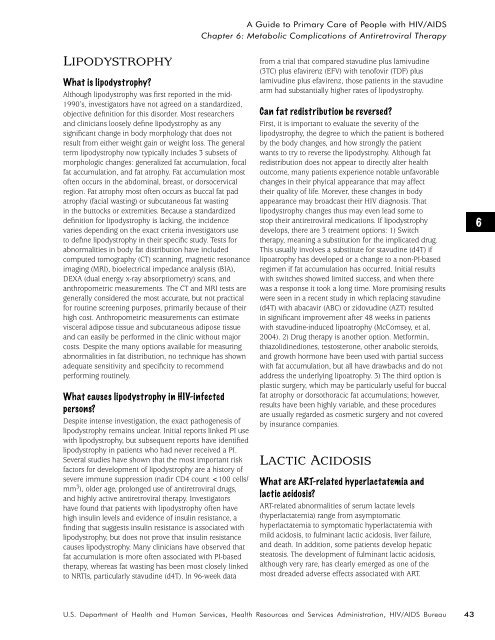A Guide to Primary Care of People with HIV/AIDS - Canadian Public ...
A Guide to Primary Care of People with HIV/AIDS - Canadian Public ...
A Guide to Primary Care of People with HIV/AIDS - Canadian Public ...
Create successful ePaper yourself
Turn your PDF publications into a flip-book with our unique Google optimized e-Paper software.
A <strong>Guide</strong> <strong>to</strong> <strong>Primary</strong> <strong>Care</strong> <strong>of</strong> <strong>People</strong> <strong>with</strong> <strong>HIV</strong>/<strong>AIDS</strong><br />
Chapter 6: Metabolic Complications <strong>of</strong> Antiretroviral Therapy<br />
LIPODYSTROPHY<br />
What is lipodystrophy?<br />
Although lipodystrophy was first reported in the mid-<br />
1990’s, investiga<strong>to</strong>rs have not agreed on a standardized,<br />
objective definition for this disorder. Most researchers<br />
and clinicians loosely define lipodystrophy as any<br />
significant change in body morphology that does not<br />
result from either weight gain or weight loss. The general<br />
term lipodystrophy now typically includes 3 subsets <strong>of</strong><br />
morphologic changes: generalized fat accumulation, focal<br />
fat accumulation, and fat atrophy. Fat accumulation most<br />
<strong>of</strong>ten occurs in the abdominal, breast, or dorsocervical<br />
region. Fat atrophy most <strong>of</strong>ten occurs as buccal fat pad<br />
atrophy (facial wasting) or subcutaneous fat wasting<br />
in the but<strong>to</strong>cks or extremities. Because a standardized<br />
definition for lipodystrophy is lacking, the incidence<br />
varies depending on the exact criteria investiga<strong>to</strong>rs use<br />
<strong>to</strong> define lipodystrophy in their specific study. Tests for<br />
abnormalities in body fat distribution have included<br />
computed <strong>to</strong>mography (CT) scanning, magnetic resonance<br />
imaging (MRI), bioelectrical impedance analysis (BIA),<br />
DEXA (dual energy x-ray absorptiometry) scans, and<br />
anthropometric measurements. The CT and MRI tests are<br />
generally considered the most accurate, but not practical<br />
for routine screening purposes, primarily because <strong>of</strong> their<br />
high cost. Anthropometric measurements can estimate<br />
visceral adipose tissue and subcutaneous adipose tissue<br />
and can easily be performed in the clinic <strong>with</strong>out major<br />
costs. Despite the many options available for measuring<br />
abnormalities in fat distribution, no technique has shown<br />
adequate sensitivity and specificity <strong>to</strong> recommend<br />
performing routinely.<br />
What causes lipodystrophy in <strong>HIV</strong>-infected<br />
persons?<br />
Despite intense investigation, the exact pathogenesis <strong>of</strong><br />
lipodystrophy remains unclear. Initial reports linked PI use<br />
<strong>with</strong> lipodystrophy, but subsequent reports have identified<br />
lipodystrophy in patients who had never received a PI.<br />
Several studies have shown that the most important risk<br />
fac<strong>to</strong>rs for development <strong>of</strong> lipodystrophy are a his<strong>to</strong>ry <strong>of</strong><br />
severe immune suppression (nadir CD4 count

















